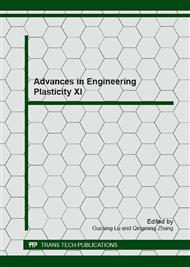p.522
p.526
p.530
p.534
p.539
p.543
p.547
p.553
p.557
Response of 1100-H12 Aluminum Targets to Varying Span and Configuration
Abstract:
The influence of target span as well as configuration was studied with 1 mm thick 1100H12 aluminum target subjected to19 mm diameter ogive nosed projectile impact. The effective span of 1 mm thick monolithic target was varied as 95, 190, 285, 380 and 475 mm. The configuration of 255 mm span diameter target was varied as 1 mm thick monolithic, double layered in-contact (2 x 0.5 mm) and double layered spaced. The spacing between the layers was also varied as 2, 5, 10 and 20 mm. The target was impacted normally by ogive nosed projectile to obtain the ballistic limit, failure mode and deformation. The ballistic limit was found to increase with an increase in span diameter. The monolithic target offered highest ballistic limit followed by layered in-contact and spaced targets respectively. The variation of spacing between the layers did not have significant influence on the ballistic limit.
Info:
Periodical:
Pages:
539-542
Citation:
Online since:
January 2013
Authors:
Keywords:
Price:
Сopyright:
© 2013 Trans Tech Publications Ltd. All Rights Reserved
Share:
Citation:


